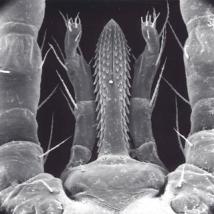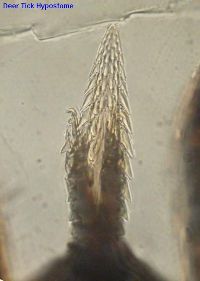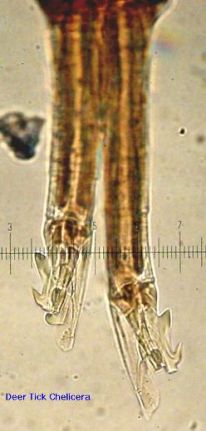
Live and Learn!
The deer tick’s body, which now have fused together through
evolution, consists of the capitulum and the idiosoma. The
mouth parts, chelicerae, palps and hypostome, are found in the
capitulum. The idiosoma is again broken down into the podosoma
and the opisthosoma. The podosoma consists of the walking legs
and the genital pore and the opisthosoma is characterized by the
spiracles and the anal aperture. Many of these
evolutionary changes have helped the ticks adapt to their
environment and feeding ritual.
The specialized mouthparts have had a huge impact of the tick’s
success as a parasite. Like stated above there are three main
mouthparts found within the capitulum, the hypostome, cheliceral,
and the palps. The two outermost structures of the mouthparts are
the two highly mobile palps; between them are the paired chelicerae,
which in turn protect the hypostome which is the center rod-shaped
structure.


 The
hypostome is the primary organ for attachment to the host’s skin. It
is covered with numerous, recurved teeth that are placed into the
host’s skin. The teeth located on the hypostome progressively get
smaller and fewer towards the proximal portion. At the distal tip of
the hypostome there are small clusters of tiny denticles. The
hypostome itself is hollow except for the very distal end. Deep
groove on the dorsal side of the hypostome allow the blood from the
host to be brought into the mouth and pharynx.
The
hypostome is the primary organ for attachment to the host’s skin. It
is covered with numerous, recurved teeth that are placed into the
host’s skin. The teeth located on the hypostome progressively get
smaller and fewer towards the proximal portion. At the distal tip of
the hypostome there are small clusters of tiny denticles. The
hypostome itself is hollow except for the very distal end. Deep
groove on the dorsal side of the hypostome allow the blood from the
host to be brought into the mouth and pharynx.
The chelicerae are the cutting organs used by the tick to
penetrate the host’s skin and gain access to its blood. These
paired organs compromise three parts, the cheliceral base, an
elongated shaft, and the cutting digits. The cheliceral base
is a large club shaped section which contains the muscles that move
the digits. The shaft is an elongated tube that contains the tendons
for moving the digits as well as the nerves. Each shaft contains two
tendons one being larger than the other. The larger laterally
positioned flexor tendon and the smaller medially positioned
extensor tendon which function to bend the digits. At the anerior
end, the cheliceral is modified with digits. These structures are
homologous to the pincer-like chelae of other arachnids.
 However,
in ticks the modified digits are equipped with broad heavily
sclerotized cusps or spine-like teeth, different from the
scissor-like grasping arrangement of other arachnids. All of the
cusps are oriented in the horizontal plane, so that most of the
cutting action is lateral. In effect, tick chelicrae can cut but
cannot grasp, as they cannot rotate or pronate. The digits are used
to rip and tear the hosts skin to expose the dermis. When the digits
are not being used they are retracted within the chelicea sheaths
that surround the elongated shaft. When needed, the cheliceral
digits are protruded by hydrostatic pressure. These digits are
limited by the flexibility and extensibility of the cheliceral
sheaths. Another adaptive feature of the digits is mechanosensory,
chemosensory, and thermosensory sensilla found on the digit spines.
Together, these sensilla provide information on the biochemical
characteristics of the wound site environment. They can use this
sensory adaption to detect minute differences in skin tissue
temperatures. These types of sensory information facilitate blood
sucking behavior. In males, the cheliceral digits are used to
probe the female’s vulva, and detect the female genital sex
pheromone which initiates the mating ritual.
However,
in ticks the modified digits are equipped with broad heavily
sclerotized cusps or spine-like teeth, different from the
scissor-like grasping arrangement of other arachnids. All of the
cusps are oriented in the horizontal plane, so that most of the
cutting action is lateral. In effect, tick chelicrae can cut but
cannot grasp, as they cannot rotate or pronate. The digits are used
to rip and tear the hosts skin to expose the dermis. When the digits
are not being used they are retracted within the chelicea sheaths
that surround the elongated shaft. When needed, the cheliceral
digits are protruded by hydrostatic pressure. These digits are
limited by the flexibility and extensibility of the cheliceral
sheaths. Another adaptive feature of the digits is mechanosensory,
chemosensory, and thermosensory sensilla found on the digit spines.
Together, these sensilla provide information on the biochemical
characteristics of the wound site environment. They can use this
sensory adaption to detect minute differences in skin tissue
temperatures. These types of sensory information facilitate blood
sucking behavior. In males, the cheliceral digits are used to
probe the female’s vulva, and detect the female genital sex
pheromone which initiates the mating ritual.
The final part of the capitulum is the leg-like palps. There are
four distinct pairs of palps and the most posterior pair is reduced
in size and can be retracted or protruded as needed.

The idiosoma is divided into 6 segments which contain 4 pairs of walking legs. The function of the legs is for movement when extended and or for protection when folded against the body. On the dorsal surface of leg one there is a special organ called the Haller’s organ which is specialized in determining host location, host odors, and also detecting pheromones as well as other sensory functions.
To learn how I satisfy my thirst for blood click here
To Main Page